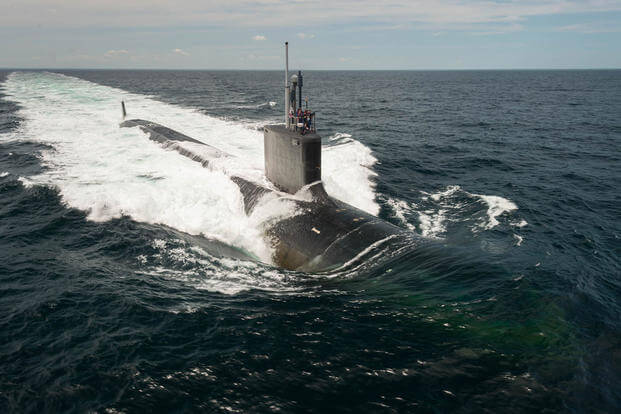Foxborough, Mass. — Secretary of the Navy Ray Mabus announced that SSN 798, a Virginia-class attack submarine, will bear the name USS Massachusetts during a taped video message at Gillette Stadium.
The submarine will be named to honor the history its namesake state has with the Navy. This history extends to 1775, before the official founding of the United States, to the time when George Washington founded the Continental Navy in an effort to protect the 13 colonies from British attack. By 1800, six years after the establishment of the Department of the Navy, one of its first 14 ship yards was incorporated in Boston. And in 1836, The Boston Naval Hospital, one of the first of three hospitals dedicated solely to the care of naval personnel, opened.
The future USS Massachusetts will be the fifth Navy vessel to serve under that name; the first, a wooden steamer, was a privately owned ship built in Boston in 1845 and purchased by the War Department in 1847. It served as a troop transport for the Army before being transferred to the Department of the Navy in 1849. Before being decommissioned in 1852, it served by scouting potential sites for lighthouses on the West Coast. After being recommissioned in 1854, it transported guns and ammunition during the Puget Sound War. Five years later, it was transferred back to the Army to cruise the Puget Sound providing protection for the inhabitants of the region. In 1862, it was transferred back to the Navy and a year later was converted to a storeship serving in this capacity until its final decommission in 1867.
The second Massachusetts, built in 1860, also in Boston, was bought and commissioned by the Navy in 1861. She was an iron screw steamer whose service spanned for the entire Civil War. A day after joining her squadron in Pensacola, Florida, Massachusetts took her first British ship, Perthshire. Over the course of the next month, Massachusetts overpowered seven more ships of Mexican and Confederate origins. Her record continued along these lines until the end of the year when she worked at intercepting Confederate freight shipments in Ship Island's passage until early 1862 when she was decommissioned in New York. She commissioned again in April of that year and served as a supply ship until December when she decommissioned again. In 1863, she recommissioned and continued defeating Confederate ships until the end of the war in 1865.
The third ship to bear the name had a long history. A battleship commissioned in 1896, it spent the first two years of its service conducting training exercises off the Atlantic coast before being assigned to blockade duties in Cuba in 1898. There she bombarded a Spanish cruiser and multiple fortifications. A couple of months later, Massachusetts returned to her duties cruising the Atlantic Coast for about seven years before briefly becoming a training ship for the Naval Academy. Shortly thereafter she began a pattern of being decommissioned and recommissioned to serve as a training ship before moving to Yorktown, Virginia in 1918 to become a heavy gun target practice ship until the end of World War I. A year later, Massachusetts was decommissioned for a final time.
The final Massachusetts was a battleship commissioned during the middle of World War II, in 1942. Within days of being launched, she had joined the conflict off the coast of North Africa and sunk two French ships. In addition, she played a vital role during the war for her defense against the Japanese, largely through her participation in fleet and air strikes. She was decommissioned in 1947, but received 11 Battle Stars for her actions and has been preserved in Fall River, Massachusetts as a memorial for those who served in World War II.
Virginia-class attack submarines provide the Navy with the capabilities required to maintain the nation's undersea supremacy well into the 21st century. They have enhanced stealth, sophisticated surveillance capabilities and special warfare enhancements that will enable them to meet the Navy's multi-mission requirements.
These submarines have the capability to attack targets ashore with highly accurate Tomahawk cruise missiles and conduct covert, long-term surveillance of land areas, littoral waters or other sea-based forces. Other missions include anti-submarine and anti-ship warfare; mine delivery and minefield mapping. They are also designed for special forces delivery and support.
Each Virginia-class submarine is 7,800-tons and 377 feet in length, has a beam of 34 feet, and can operate at more than 25 knots submerged. They are designed with a reactor plant that will not require refueling during the planned life of the ship, reducing lifecycle costs while increasing underway time. The submarine will be built under a unique teaming agrement between General Dynamics Electric Boat and Huntington Ingalls Industries' Newport News Shipbuilding division wherein both companies build certain portions of each submarine and then alternate deliveries. Massachusetts will be delivered by Huntington Ingalls Industries' Newport News Shipbuilding.


























